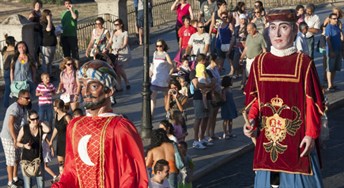The Giants of Corpus Christi in Toledo
 In 1980, the Corpus Christi of Toledo was declared by the Spanish government to be of International Touristic Interest. Its history, however, is much older. It dates back to the Middle Ages. Corpus Christi is a liturgical ceremony that celebrates the real presence of Christ in the Eucharist. It is held on the Thursday after Pentecost (a movable feast which falls on the fiftieth day after Easter Sunday). For the occasion, the streets and the balconies of the city of Toledo are decorated with flowers and carpets and the splendid Gothic Cathedral of Santa Maria, in which is one of the wonders of the late Baroque Spanish (El Transparent), is embellished with 48 of seventeenth-century Flemish-school tapestries.
In 1980, the Corpus Christi of Toledo was declared by the Spanish government to be of International Touristic Interest. Its history, however, is much older. It dates back to the Middle Ages. Corpus Christi is a liturgical ceremony that celebrates the real presence of Christ in the Eucharist. It is held on the Thursday after Pentecost (a movable feast which falls on the fiftieth day after Easter Sunday). For the occasion, the streets and the balconies of the city of Toledo are decorated with flowers and carpets and the splendid Gothic Cathedral of Santa Maria, in which is one of the wonders of the late Baroque Spanish (El Transparent), is embellished with 48 of seventeenth-century Flemish-school tapestries.
On the eve of Corpus Christi the parade of giants, dwarfs (gigantillas) and the Tarasca is held in the streets of Toledo. The giants of today, dating back to the middle of the eighteenth century, personify the four continents. Along with the latter, there is even a puppet in parade of Rodrigo Diaz de Bivar (1026-1099), known as El Cid, the legendary hero of the Reconquista, a Castilian knight. The participation of the giants in the procession of the Blessed Sacrament of Toledo dates back to the Middle Ages. The sources, in fact, attest to the presence of an Eagle in the latter part of the fourteenth century. The appearance of the continental giants, accompanied by the Tarasca surmounted by the puppet of Anne Boleyn (the tarasquilla), dates back to 1493.
